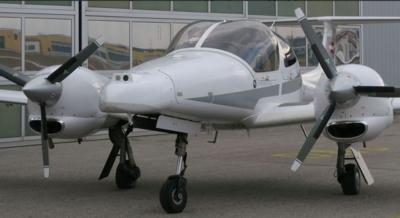Thu, Nov 17, 2016
System Should Improve Safety For Both Manned And Unmanned Flights
In close cooperation, experts of the AIT Austrian Institute of Technology and Diamond Aircraft Industries GmbH, have developed an intelligent sensor system enabling aircraft to detect and avoid potential obstacles both in the air and on the ground. This innovative airborne assistance system is an important step towards improving the safety of manned and unmanned flight.

Collision avoidance systems are a key technology for future unmanned aerial systems and advanced air traffic services. The objective is to increase the safety of manned and future unmanned aviation by detecting possible collisions with both cooperative and non-cooperative obstacles, and performing avoidance maneuvers as a last resort to avoid collisions. Obstacle avoidance is the key technology in missions involving the highest possible degree of autonomy, e.g. for generating situation maps for crisis and disaster management.
Experts at AIT have taken an innovative vision-based approach, enabling future unmanned aerial systems to observe and understand their environment in real-time. This approach goes beyond the state-of-the-art, making use of novel sensing techniques and route planning strategies for collision avoidance. The technology is capable of detecting both cooperative and non-cooperative objects in the airspace by fusing passive electro-optical and thermal-infrared sensor data. The technology was integrated in a Diamond Aircraft DA42 MPP and demonstrated in relevant scenarios.

Diamond Aircraft has used the test results to assess potential applications for this technology as an innovative and effective safety-improving feature both for unmanned flying objects and manned aviation. One option would be to integrate the technology into an autonomous flight control system similar to the one developed during a recent Diamond Aircraft project which, in 2015, successfully demonstrated safe autonomous flying for manned aircraft in emergency situations, including completely automated landing. Another possible use could be sensorial integration into conventional manned aircraft, to increase situational awareness and prevent collisions with airborne or ground obstacles. This would offer an additional and more reliable pair of artificial “eyes” able to generate potentially life-saving collision avoidance advisories.
(Images provided with Diamond Aircraft news release)
More News
Aero Linx: Transport Canada We are a federal institution, leading the Transport Canada portfolio and working with our partners. Transport Canada is responsible for transportation p>[...]
Gross Navigation Error (GNE) A lateral deviation from a cleared track, normally in excess of 25 Nautical Miles (NM). More stringent standards (for example, 10NM in some parts of th>[...]
From AirVenture 2017 (YouTube Edition): Flight-Proven Booster On Display At AirVenture… EAA AirVenture Oshkosh is known primarily as a celebration of experimental and amateu>[...]
Aircraft Parachute System (CAPS) Was Deployed About 293 Ft Above Ground Level, Which Was Too Low To Allow For Full Deployment Of The Parachute System Analysis: The day before the a>[...]
Also: 48th Annual Air Race Classic, Hot Air Balloon Fire, FAA v Banning 100LL, Complete Remote Pilot The news Piper PA-18 Super Cub owners have been waiting for has finally arrived>[...]
 ANN's Daily Aero-Linx (06.29.25)
ANN's Daily Aero-Linx (06.29.25) ANN's Daily Aero-Term (06.29.25): Gross Navigation Error (GNE)
ANN's Daily Aero-Term (06.29.25): Gross Navigation Error (GNE) Classic Aero-TV: Anticipating Futurespace - Blue Origin Visits Airventure 2017
Classic Aero-TV: Anticipating Futurespace - Blue Origin Visits Airventure 2017 NTSB Final Report: Cirrus SR22
NTSB Final Report: Cirrus SR22 Airborne Affordable Flyers 06.26.25: PA18 Upgrades, Delta Force, Rhinebeck
Airborne Affordable Flyers 06.26.25: PA18 Upgrades, Delta Force, Rhinebeck




